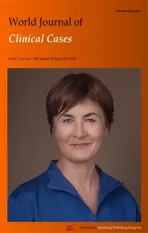Acute generalized exanthematous pustulosis with airway mucosa involvement:A case report
2020-09-16LuLuLiYuanQiangLuTongLi
Lu-Lu Li,Yuan-Qiang Lu,Tong Li
Lu-Lu Li,Yuan-Qiang Lu,Tong Li,Department of Emergency Medicine,The First Affiliated Hospital,School of Medicine,Zhejiang University,Hangzhou 310003,Zhejiang Province,China
Abstract
Key words:Acute generalized exanthematous pustulosis;Airway mucosa;Traditional Chinese medicine;Heavy metals;Case report
INTRODUCTION
Acute generalized exanthematous pustulosis (AGEP) is a severe cutaneous adverse reaction characterized by sterile pustules on erythematous skin associated with fever,leukocytosis and pustular erosions.The annual incidence of AGEP is estimated to be 1-5 cases per million[1,2].It was first reported and named by Beyrotet al[3]in 1980.We present the rare case of a 42-year-old woman who developed serious AGEP involving the airway mucosa.
CASE PRESENTATION
Chief complaints
Rash,fever for 8 d,and dyspnea for 12 h.
History of present illness
The 42-year-old Chinese woman initially presented with fever and a small rash on her forehead and face.Over the next 2 d,she developed a diffuse,pustular,itchy rash over her trunk and legs.She also complained of a cough with white foam-like sputum,and chest tightness.Four days later,due to dyspnea,her mental status started to gradually deteriorate.She required supplemental oxygen.She then became more and more drowsy.Six days later,she received endotracheal intubation and ventilator support and was admitted to the intensive care unit.She was a housewife,1.62 m in height with a body weight of 55.4 kg.
History of past illness
She had a history of lumbar disc herniation.She had taken traditional Chinese medicine for back pain 1 d before the onset of fever and rash.
Personal and family history
She had no other past medical history,and no family history of similar diseases or psoriasis.
Physical examination
Physical examination showed diffuse,pustular rashes over her trunk and extremities(Figure 1).
Laboratory examinations
Laboratory studies showed a white cell count of 15.3 × 109/L,neutrophils of 87.3%,Creactive protein of 208.00 mg/L,and procalcitonin of 0.18 ng/mL.Blood gas analysis showed pH 7.35,PaO262.1 mmHg,PaCO258.3 mmHg,and HCO3-31 mmol/L.A large number of white cells were seen in the pustular fluid smear.Pustular fluid culture was negative.Anti-nuclear antibody,anti-neutrophil cytoplasm antibody,antimitochondrial antibody,TB-GeneXpert,and T-spot were within normal limits.All blood and pustular fluid cultures were negative.

Figure 1 Diffuse pustular rash of the trunk and legs.A:Diffuse,pustular rash of the trunk;B:Diffuse pustular rash of the legs.
Imaging examinations
Lung computed tomography showed that the airway space was occupied and tracheoscopy was recommended.Tracheoscopy revealed an unidentified protrusion in the main bronchus (Figure 2).
Pathological findings
Skin and airway mucosa biopsies showed subepidermal bullous formation containing scattered neutrophils and eosinophils with occasional subcorneal neutrophilic pustules,which suggested the diagnosis of AGEP (Figure 3).
FINAL DIAGNOSIS
According to the European study of severe cutaneous adverse reactions group scoring system,used in the identification of AGEP,the patient scored +6,indicating a probable diagnosis of AGEP.Her final diagnosis was AGEP,acute respiratory failure (type II),and pulmonary encephalopathy.
TREATMENT
On hospital day 5,broad spectrum antibiotics were discontinued.The patient then received intravenous methylprednisolone 120 mg/12 h on hospital day 6.
OUTCOME AND FOLLOW-UP
Following treatment with intravenous methylprednisolone,the patient's rash began to subside and there was desquamation of the skin after AGEP resolution (Figure 4A).The pustules gradually dried up and scabbed (Figure 4B).Post-treatment bronchoscopy showed that the airway was unobstructed (Figure 4).The patient was eventually discharged in good condition under instructions to avoid traditional Chinese medicine.
DISCUSSION
The diagnosis of AGEP includes the following:(1) Fever >38°C;(2) Acute pustular eruption;(3) Neutrophilia;(4) Subcorneal or intra-epidermal pustules on skin biopsy;and (5) Spontaneous resolution within 15 d[1].Our patient met all these features.
Cases of AGEP involving oral mucosa have been reported.However,cases of airway mucosa involvement are rare.The etiology of AGEP is not fully understood.More than 90% of AGEP cases are caused by drugs,such as aminopenicillins,pristinamycin,hydroxychloroquine,quinolones,sulfonamides,terbinafine,ketoconazole,diltiazem,and fluconazole[4-8].Additional causes of AGEP,such as contact with mercury[9],have also been described.In this case,the patient took traditional Chinese medicine before the onset of the disease;thus,the possibility of AGEP caused by heavy metals in the traditional Chinese medicine or the traditional Chinese medicine itself should be considered.

Figure 2 Lung computed tomography findings and the first tracheoscopy.A:Lung computed tomography;B:Tracheoscopy.The main bronchus was occupied.

Figure 3 Skin and airway mucosa biopsy (magnification 100 ×).A:Skin mucosa biopsy;B:Airway mucosa biopsy.Subepidermal bullous formation containing scattered neutrophils and eosinophils.
AGEP is a self-limited disease with a short course and good prognosis.In severe cases,glucocorticoids should be administered.The mortality rate is less than 5%,and death is usually caused by multiple organ dysfunction and diffuse intravascular coagulation.Patients with a high risk of death are generally associated with other diseases or extensive skin lesions and mucous membrane involvement[10].This patient had already experienced respiratory failure and airway mucosa involvement on admission;however the clinicians had an insufficient understanding of AGEP.A glucocorticoid was administered for more than 10 d after onset of the disease,and the overall prognosis was satisfactory.
CONCLUSION
AGEP is a self-limited disease with a good prognosis.This case represents a rare clinical feature of AGEP and an important finding for clinicians.Doctors should pay attention to possible AGEP,when a patient has rashes and fever.

Figure 4 Leg rashes following transfer from the intensive care unit and final tracheoscopy.A:Leg rashes following transfer from the intensive care unit;B:Final tracheoscopy.Main airway was unobstructed.
杂志排行
World Journal of Clinical Cases的其它文章
- Novel computerized psychometric tests as primary screening tools for the diagnosis of minimal hepatic encephalopathy
- Steroid-responsive pancreatitides
- Application of molybdenum target X-ray photography in imaging analysis of caudal intervertebral disc degeneration in rats
- Accuracy study of a binocular-stereo-vision-based navigation robot for minimally invasive interventional procedures
- Value of virtual bronchoscopic navigation and transbronchial ultrasound-guided sheath-guided exploration in diagnosis of peripheral lung cancer
- Significance of serum fibroblast growth factor-23 and miR-208b in pathogenesis of atrial fibrillation and their relationship with prognosis
